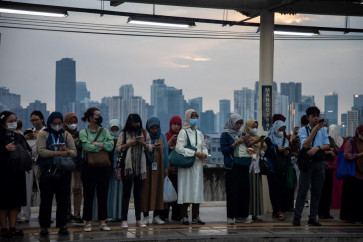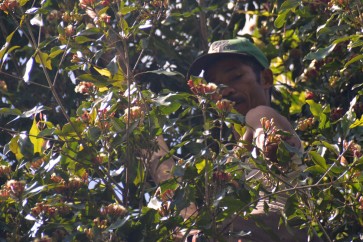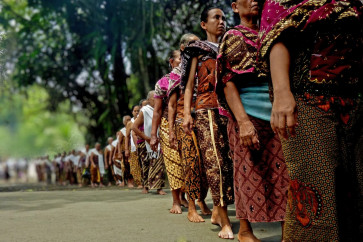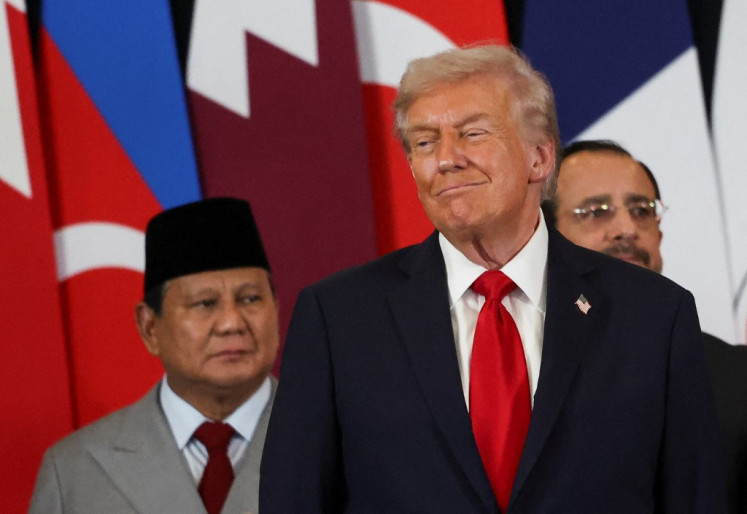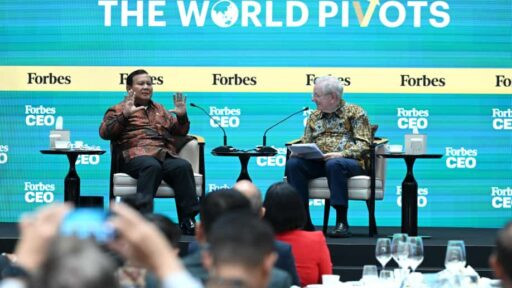Popular Reads
Top Results
Can't find what you're looking for?
View all search resultsPopular Reads
Top Results
Can't find what you're looking for?
View all search resultsPlaited arts: Preserving the craftsmanship of the rainforest
A woman works on a woven pandanus mat
Change text size
Gift Premium Articles
to Anyone
A
span class="caption" style="width: 284px;">A woman works on a woven pandanus mat.Having one of the oldest rain forests with some of the most diverse plants in the world, the people of Kalimantan have preserved rich basketry traditions. In an effort to save the basketry handicraft from extinction, Lontar Foundation, in collaboration with Total E&P Indonésie Foundation and Bentara Budaya, are exhibiting Kalimantan’s own basketry products at the Bentara Budaya Jakarta, from March 27 until April 7.
Kalimantan’s plaited arts comes from the strong bond between the people and the forest.
Basketry, one of the oldest human crafts, has existed for at least a thousand years, when people began settling down and farming. These crafts were used to create practical tools for everyday life.
The word “basketry” refers to plaited arts objects that range from containers to mats to fish traps.
The roots of Kalimantan’s basketry traditions and the successive influences that shaped them can be viewed in the broader Southeast Asian historical context.
Kalimantan, also known as Borneo, was the destination for ancient Southeast Asian migration. Local cultures absorbed influences from India and China, as well as the later visitors, the Islamic and Western worlds from around the 16th century.
Women weave pandanus handicrafts.Therefore, it is not unusual to see the similarity between the art of Borneo and items from the Dian and Zhou cultures of southern China as well as Indochina, such as Cambodia and the Dong Son culture of northern Vietnam.
“The island of Borneo, including Kalimantan, has the richest, most complex, and most varied plaited tradition in the world. Unfortunately, that fact is little known,” said John McGlynn, the chairman of Lontar Foundation, on the exhibition’s opening last week. The foundation also launched Plaited Arts from the Borneo Rainforest, a book based on studies of 20 experts on Kalimantan crafts.
“Without the combined effort on the part of the private, corporate and government sectors to promote cultural growth and development, little by little this country’s uniqueness will be whittled away and Kalimantan’s plaited baskets will be replaced by cheap plastic containers imported from abroad,” said McGlynn.
From the Borneo tropical forest, people choose rattan, bamboo, palm, screwpine (pandanus), sedge, reeds, grasses and ferns as the material for their basketry products.
The choice of plants rests mostly on practicality, such as availability, a given function — durability and resistance to water and pests — processing and dye absorbency.
The overall technique for basketry is basically the same. All products are made of manually assembled plant fibers, without the frames or looms that are used to weave textiles.
Various kinds of plaited art works.
Plaited art products are usually classified into three major technological types: plaiting, twining and coiling. Yet, there are many different sub-types for each particular technique.
Forms as well as size are primarily dictated by function. Large flat hats provide better protection against the sun and rain than narrow pointed hats.
Small baskets tied at the waist are practical for sowing paddy, whereas large burden baskets with sturdy shoulder straps are necessary to carry harvested paddy from field to village.
In terms of motifs and patterns, Kalimantan basketry has evolved along different paths, varying with local ingenuity, through styling and reinterpretation of functions.
This has allowed the makers to develop a variety of decorative styles — many are specific to certain ethnic groups, or even emblematic of certain regions. Innovation of the form is still robust today in Borneo.
Borneo’s native Dayak people name their basketry products after the natural environment, such as flowers, fruits, birds and even the person or ethnic group who invented the motif.
The most basic geometric motif, such as mata punai, or the dove’s eye (a hook) is among the common patterns found in Borneo and are called by the same name throughout the island.
Traditional baby carriers.A triangular motif, on the other hand, has several names, reflecting the variety of inspiration for the pattern. The Iban tribe calls it a bamboo shoot while the Ngaju calls it pinang (bud of the Areca palm). It is a blade point for the Kenyah while for the Aoeheng, it is durian thorn.
An eight-branched star motif is referred to as flower by the Iban; tiger footprint by the Aoeheng and manggis (mangosteen fruit) by the Ngaju.
“Each motif and pattern in Dayak basketry represents three main symbols, which are gods, human relations and the environment.
“Those ornaments are also usually seen in the Dayak’s Batang Garing plaited tree of life craft,” said Central Kalimantan Governor Agustin Teras Narang, who is also the president of Majelis Adat Dayak Nasional (the National Dayak Tribe Council).
It is not uncommon to uncover an elaborate story behind a pattern. Mats, hats or baskets may carry or refer to pictorial narratives — as do certain Ngaju ritual objects — which tell stories of mythical heroes, spirits and gods. They carry profound social and ritual significance.
At the exhibition, guests can enjoy hundreds of Dayak basketry products. From fan palm hats with various motifs and colors to rattan or pandanus mats with signature motifs and sometimes hidden stories beneath the motifs. Visitors can take a glimpse in to the daily and spiritual habits of the forest people.
There are also rattan and bamboo functional baskets in many shapes and sizes. Many products such as seat mats, baby carriers and food covers are all very practical.
Last but not least is, of course, the baskets. From animal-shaped to betel baskets, they are easy to carry and serve a reminder of the rain forest.
— Photos by Ricky Yudhistira





